

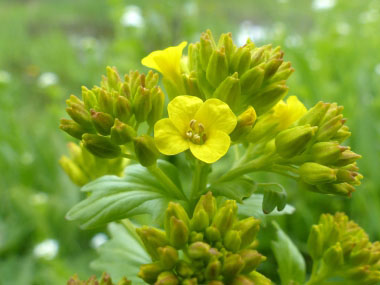
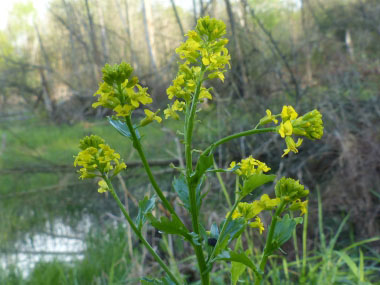
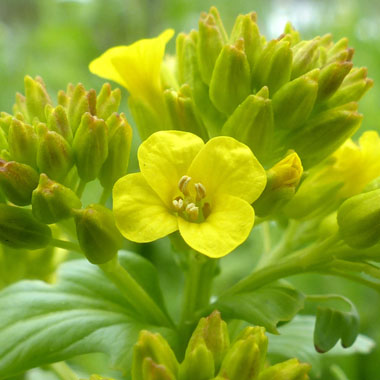
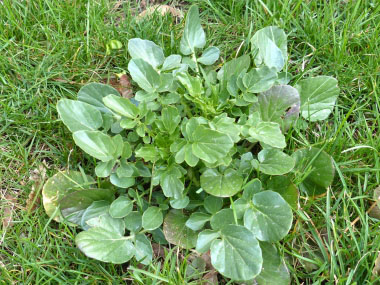
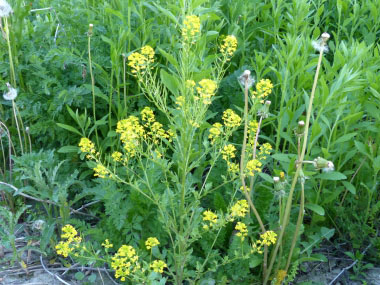
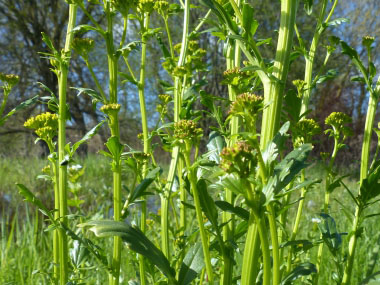
To support our efforts please browse our store (books with health benefits, etc.).
Yellow rocket is a perennial that flowers from May to August and adds colour to fields, gardens and roadsides. This plant is often confused with wild mustard but it can be distinguished from wild mustard by its smaller, deeper golden yellow flowers, hairless leaves that are a glossy green or may even be slightly purplish in colour, the large terminal lobe within the leaves. If the winter season is not too severe, this plant can be found and collected throughout the winter. Sometimes it even stays green underneath the snow.
Distinguishing Features
Yellow rocket has bright golden yellow flowers, shiny green leaves (may also be slightly purplish in color) with lots of small leaves and one large terminal lobe.
Flowers
Yellow rocket flowers are yellow and often appear in a cluster. Each flower measures 1 to 1.5 cm across. The flower has four petals generally appearing in the formation of a cross. The flower has six stamens, two are short and four are long. During the second year of growth flowers can occur at any time once matured.
 Fields
of Nutrition has medicinal benefits and vitamin/mineral content of Yellow Rocket.
Fields
of Nutrition has medicinal benefits and vitamin/mineral content of Yellow Rocket.
Leaves
Long-stalked and hairless, shiny dark green leaves, basal leaves measure 5-20 cm long, lobed with one large terminal lobe and one to four oppositely-arranged lateral lobes. Terminal lobes are heart-shaped. At the top of the plant the leaves are much smaller and less lobed. All leaves are alternate with wavy and toothed margins.
Height
20 cm to 80 cm.
Habitat
Yellow rocket can be found in moist meadows, pastures, amongst crops and fields, gardens, vacant lots, construction sites, along roadsides, and throughout waste areas. Yellow rocket especially likes moist rich soil.
Edible Parts
The basal leaves are edible early spring but later become bitter, although still edible. At this stage they can be chopped up and added to salads like rucola, which has a similar tang. The leaves can be cut up fresh over salads, older leaves can be used in stews or soups, or you can dry the leaves to make tea. Flowering stems can be cooked like broccoli.
Other Name
Wintercress.
Similar Plants
Wild Mustard.
Recipes
Winter Survival Food Handbook

PDF Plant Magazines
Types of Wild Food
Geographic Zones Seasons
Disclaimer
EdibleWildFood.com is informational in nature. While we strive to be 100% accurate, it is solely up to the reader to ensure proper plant identification. Some wild plants are poisonous or can have serious adverse health effects.
We are not health professionals, medical doctors, nor are we nutritionists. It is up to the reader to verify nutritional information and health benefits with qualified professionals for all edible plants listed in this web site. Please click here for more information.
Why Edible Wild Food?
- Food costs are rising
- Free, wild food is readily abundant
- Wild food adds nutrition to your diet
- Wild food can help treat various medical conditions





